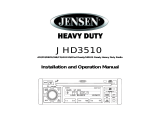
JRV212T
13
WEATHER BAND OPERATION
What is the NOAA Weather Radio/Weatheradio Canada?
NOAA (National Oceanic and Atmospheric Administration) is a nationwide system that broadcasts
local weather emergency information 24 hours a day via the National Weather Service (NWS)
network. The U.S. network has more than 530 stations covering the 50 states as well as the
adjacent costal waters, Puerto Rico, the U.S. Virgin Islands and the U.S. Pacific Territories. Each
local area has its own transmitting station and there are a total of seven broadcasting frequencies
used. A similar system is available in Canada under the Weatheradio Canada service administered
by Environment Canada.
Weather Band Selection
1. Press the AUDIO button (4) on the control panel to enter Audio mode (if needed).
2. Touch the “WB” button on the touch screen to access the weather band (NOAA seven
frequency broadcast).
The indication "WB" will appear on the display panel, along with the current number and
channel indication: "WB-1", “WB-2", "WB-3", "WB-4", "WB-5", "WB-6" or "WB-7".
3. Touch the “TUNE+” or “TUNE-” button to tune to a weatherband station or touch the a button
labeled 1-7 to access one of the seven weatherband channels directly. The seven frequencies
are shown in the following table:
This table also shows which preset button will access the frequency. Note that one frequency
cannot be accessed using a preset button. The frequency can only be reached using the tuning
controls.
NOTE: The weather band channel frequency is fixed in preset memory and cannot be
changed.
NOAA Weather Alert
The Weather Alert function adds an additional level of user safety by automatically switching from
any of the available function modes to weather band for a minimum of 60 seconds if a NOAA
warning tone (1050 Hz) is received/detected. If no additional warning tone is received for 60
seconds, the unit will switch back to the last known function mode.
The JRV212T is equipped with a weather alert level (Min Alert Level) and weather alert power
(Auto-On Enable) feature that will cause the radio to turn on automatically when a weather alert is
detected, adding an additional level of user safety. When the weather alert level is set to “All”,
“Warnings” or “Watches” the weather alert function automatically switches from any of the available
function modes (Tuner, SIRIUS, CD, iPod, AUX) to Weather Band when the selected NOAA
warning type is received/detected.
See “System Menu” on page 9 to learn how to turn the Min Alert Level and Auto-On Enable features
on.
SAME Decoding and Filtering
Specific Area Message Encoding (SAME) data is also broadcast prior to alert broadcasts. SAME
data contains information about the geographic region affected by the alert, the type of alert, and its
effective time. The geographic region included in the SAME data is called the Geographical Area
code and has the form PSSCCC where “P” represents a portion of the county, “SS” is a two-digit
state, territory, or offshore marine area identifier and “CCC” identifies the county, province, or major
metropolitan area within the state. This unit can be configured through the system setting menu with
up to seven Geographical Area codes to limit the automatic tuning or power on functions described
above.
SAME data also includes the type of alert being broadcast. This unit can be configured through the
System Setting Menu to limit the automatic tuning or power on functions based on the type of alert.
SAME is activated by programming a 6 digit code - called a FIPS code - into your radio. The FIPS
code or Federal Information Processing System code is a six digit code that identifies the states and
counties (or parishes) in the United States. The first digit identifies the county subdivision. The next
two digits identify the state or territory, and the last three identify the county. The FIPS code for your
area can be found by calling the NWS toll free number or visiting the web site.
The phone number is 1-888-NWS-SAME (1-888-697-7263) Upon calling, an automated system will
prompt you to enter your state and county. When you confirm the information, the system will
provide your six digit FIPS code.
The web site is: www.nws.noaa.gov/nwr/indexnw.htm. Upon selecting your state from the chart, you
will see a listing of all the counties in that state. For each county there is a listing of the SAME#
(FIPS code), the location of the transmitter, the WB frequency, the call sign, the transmitter power
and miscellaneous remarks.
Frequency (MHz) Preset
162.400 2
162.425 4
162.450 5
162.475 3
162.500 6
162.525 7
162.550 1
AM/FM WB
TUNE+
SAT
CD
TUNE-
USB
iPOD
SEEK+
F.AUX
R.AUX
1
25
3647
162.475 Mhz





















